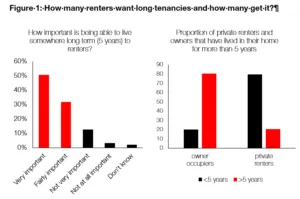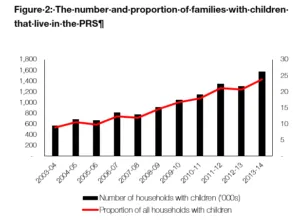How long must a family friendly private tenancy be?
Published: by John Bibby
The case for longer tenancies in the private rented sector couldn’t be clearer. The overwhelming majority of renters want to be able to live in a rented home for the long term, but only a small number ever do.
83% of private renters say that being able to stay in their rented home for five years is an important factor when they start a tenancy. But only 20% of renters ever end up living in their home for five years. 83% want it; 20% get it. (By comparison, only 20% of owner occupiers don’t end up living in their home for more than five years.)
Sources: YouGov for Shelter; English Housing Survey, DCLG
Some small progress has been made towards improving things for renters. The Coalition government developed a model longer tenancy that they hoped would encourage landlords to offer longer lets. Some institutional landlords have offered longer private tenancies, like on the Olympic Park.
But that progress has been at the extreme end of marginal and grindingly slow. Given this, it’s legitimate to question whether the call for five year tenancies is still the right one to make. Would watering it down by calling for a shorter tenancy length (e.g. two, three or four years) get us at least some change quicker?
But in my view the arguments for five year tenancies are still overwhelming – and not just because that’s what renters say they want. If anything the case for five years is now stronger than when Shelter originally called for it.
In part, the argument for five years as a minimum degree of security is about basic fairness. The minimum length of a tenancy in the social sector is five years. It’s not fair that private renters get a worse deal.
In part, the argument is economic. The vast majority of landlords say that they intend to be in the market for at least five years. A stable and predictable rental income is good for them too.
But the principal reason to support five years as a minimum has little to do with demand, fairness or economics. It is that, increasingly, families are bringing up children in the private rented sector – and families with children need a significant degree of stability.
Over the last ten years there has been a profound and rapid societal shift in how families with children in England are housed. It’s hard to overstate how significant it’s been.
Ten years ago fewer than one in ten families with children were privately renting. It’s now one in four. That means that over a million more families with children are now renting privately compared to ten years ago.
Source: English Housing Survey, DCLG
At Shelter we know both from the families who use our services, and from our own research, what the impact on private renting families can be when they are forced to move home. It inevitably implies moving costs and stress. But more important is the impact on the children. Being forced to move home repeatedly can often mean children having to leave behind friends or change schools.
Five years of security is the minimum security families need. It’s the length of secondary education: the difference between a child being able to finish their GCSEs at the same secondary school or not. It’s also the length of pre-school infancy: the difference between a parent being forced to look for a new home when their child is just a toddler or not.
Families from all tenures are forced to move sometimes, for work reasons for example. But no childhood should be defined by instability. And fundamentally, five year tenancies would be the difference between a child who grows up renting being forced to move a maximum of three times rather than six.
Sometimes compromise is necessary to achieve change more quickly. But for the quarter of families with children that are growing up as private renters, five years is the absolute minimum security they need.

